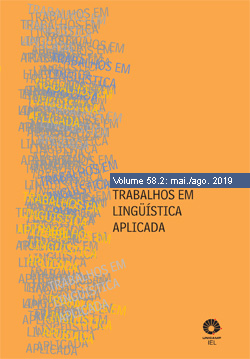Abstract
The positioning of the verb ser corresponds to a logical and pragmatic-discursive necessity, before than linguistic-formal one, useful to emphasize some sentence constituent. We will analyze the focalizing role of the copula, and we will compare the spanish cleft sentences with their corresponding italian phrases too, trying to make emerge the coincidences and divergences.
Then, we will study the management of these marked structures, in which the dislocation of some of its elements serves to highligh the relevant informative core of the message. Finally, we will reflect on the advantages derived from a didactic use of this discourse strategy (S/FL).
References
ALARCOS, E. (1970). Estudios de gramática funcional del Español, Madrid: Gredos.
BORREGUERO ZULOAGA, M. (2015). El gato, que ha tirado un vaso: ¿construcciones escindidas en el español coloquial?, Revista internacional de lingüística iberoamericana, XIII, 2 (26), pp. 101-122.
D’ACHILLE, P.;PROIETTI, D.;VIVIANI, A. (2005). La frase scissa in italiano: aspetti e problemi, in Tipologia linguistica e società. Considerazioni inter e intralinguistiche. Due Giornate italo-danesi di studi linguistici (Roma, 27-28 novembre 2003), al cuidado de I. Korzen & P. D’Achille, Firenze: Cesati, pp. 249-279.
DEL BARRIO DE LA ROSA, F. (2015). Las funciones informativas, in GREIT Gramática de referencia de español para italófonos (dir. Félix San Vicente), Salamanca: CLUEB Universidad de Salamanca, pp. 1277-1307.
DE MAURO, T. et alii (1993). Lessico di frequenza dell’italiano parlato. Milano: EtasLibri.
D’INTRONO, F. (1979). Sintaxis transformacional del Español, Madrid: Cátedra.
DI TULLIO, Á. (1990). Sobre hendidas y pseudohendidas, Revista de Lengua y Literatura, 7, pp. 3-16.
DUFTER, A. (2010). El que galicado: distribución y descripción gramatical, in La ‘excepción’ en la gramática española. Perspectivas de análisis (A. Zamorano Aguilar; C. Sinner eds.), Madrid & Frankfurt: Iberoamericana Vervuert, pp. 253-278.
FANT, L. (1984). Estructura informativa en español: estudio sintáctico y entonativo. Estocolmo, Uppsala: Almqvist & Wiksell.
FERNÁNDEZ RAMÍREZ, S. (1951). Gramática española 4. El verbo y la oración, Madrid: Arco Libros.
FUENTES RODRÍGUEZ, C. (2017). (I+D+I MesA Microsintaxis del español actual). El enunciado: estructura y relaciones, Lingüística en la red, 14.
GUTIÉRREZ ORDÓÑEZ, S. (2015). La familia de las ecuacionales, Revista internacional de lingüística iberoamericana, XIII, 2 (26), pp. 15-37.
JESPERSEN, O. (1924). The Philosophy of Grammar, Chicago and London: The University of Chicago Press.
KANAGY, R. (1995). Interactional routines as a mechanism for L2 acquisition and socialization in an immersion context, Journal of Pragmatics, 31, pp. 1467-1492.
KASPER, G. (2000). Four perspectives on L2 pragmatic development, in Annual Conference of the American Association of Applied Linguistics, Vancouver, pp. 1-46.
LAMBRECHT, K. (1994). Information Structure and Sentence Form: Topic, Focus and the Representation of Discourse Referents. Cambridge: Cambridge University Press.
LEONETTI, M. (2014). Gramática y pragmática en el orden de palabras, Lingüística en la red, 12, pp. 1-25.
LÓPEZ GARCÍA, A. (1996). Gramática del español, Madrid: Arco/Libros.
MARTÍNEZ, J.A. (1994). Cuestiones marginadas de gramática española, Madrid: Istmo.
MORENO CABRERA, J. C. (1999). Las funciones informativas: las perífrasis de relativo, in I. Bosque, V. Demonte (Eds.), Gramática descriptiva de la lengua española, Madrid: Espasa Calpe, pp. 4245-4302.
MORENO CABRERA, J. C. (1983). Las perífrasis de relativo, in Serta Philologica F. Lázaro Carreter, Madrid: Cátedra, pp. 455-467.
NAVARRO, M. (1998). El uso del que galicado en el habla de Valencia, Thesaurus, 53, pp. 575-581.
OHTA, A. (1995). Applying sociocultural theory to an analysis of learner discourse: learner-learner collaborative interaction in the zone of proximal development, Issues in Applied Linguistics, 6, pp. 93-121.
ORTEGA OLIVARES, J. (1988). Observaciones sobre las «fórmulas perifrásticas de relativo» in VV.AA., Studia Lilteraria atque Lingüistica, Granada, pp. 185-210.
REAL ACADEMIA ESPAÑOLA, (2009). Nueva gramática de la Lengua Española, Madrid: ESPASA.
ROGGIA, C. E. (2008). Frasi scisse in italiano e francese orale: evidenze dal C-ORAL-ROM, Cuadernos de Filología italiana, 15, pp. 9-29.
SABATINI, F. (1985). L’italiano dell’uso medio: una realtà tra le varietà linguistiche italiane, in G. Holtus, E. Radtke (al cuidado de), Gesprochenes Italienisch in Geschichte und Gegenwart, Tübingen:Gunter Narr Verlag, pp. 154-184.
SEDANO, M. (2010). El verbo ser en las oraciones pseudohendidas y con el verbo ser focalizador, Nueva Revista de Filología Hispánica, 58, 1, pp. 39-58.
SEDANO, M. (1999). El uso del llamado que galicado: posibles explicaciones, in Actas del VIII Congreso internacional de la Asociación de Lingüística y Filología de la América Latina (1987, San Miguel de Tucumán): Universidad Nacional de Tucumán.
YOSHIMI, D.R. (2001). The instruction of discourse markers in an intermediate Japanese foreign language classroom, in K. Rose, G. Kasper, Pragmatics in language teaching, New York: Cambridge University Press, pp. 223-244.
O periódico Trabalhos em Linguística Aplicada utiliza a licença do Creative Commons (CC), preservando assim, a integridade dos artigos em ambiente de acesso aberto, em que:
- A publicação se reserva o direito de efetuar, nos originais, alterações de ordem normativa, ortográfica e gramatical, com vistas a manter o padrão culto da língua, respeitando, porém, o estilo dos autores;
- Os originais não serão devolvidos aos autores;
- Os autores mantêm os direitos totais sobre seus trabalhos publicados na Trabalhos de Linguística Aplicada, ficando sua reimpressão total ou parcial, depósito ou republicação sujeita à indicação de primeira publicação na revista, por meio da licença CC-BY;
- Deve ser consignada a fonte de publicação original;
- As opiniões emitidas pelos autores dos artigos são de sua exclusiva responsabilidade.


